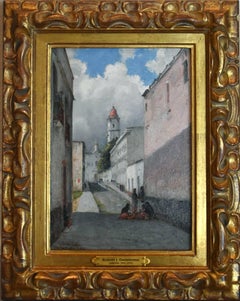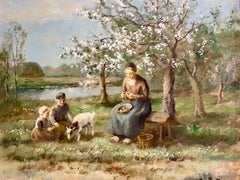Robert Jenkins Onderdonk Art
Robert Onderdonk is considered the "Dean" of Texas Painters. Onderdonk was born in Catonsville, Maryland in 1852. He received an academic education at the College of St. James, Catonsville, followed by studies at the National Academy of Design in 1872 under the instruction of Lemuel Everett Wilmarth. In 1875, Onderdonk attended Art Students League of New York and received instruction from Walter Shirlaw, James Carroll Beckwith and William Merritt Chase. Onderdonk moved to San Antonio, Texas in 1878, where he made a living teaching and selling his paintings. In 1889, he moved to Dallas, where he painted several portraits for the Hubert Portrait Company, followed by employment with the Art Students League of Dallas. In 1896, Onderdonk returned to San Antonio, Texas, where he continued to paint until he died in 1917.
Onderdonk was a member of the Allied Artists of America; Salmagundi Club, New York and the San Antonio Art League. He had a very thorough academic education and was always sketching family members, classmates and landscapes on the back of his school books. This sketching ethic was a process he subscribed to his entire life, always carrying a sketchbook with him wherever he went, like a camera of today. Deciding to make art his profession, Onderdonk moved to New York. He was not only a part of the academic beginnings of American art while studying in New York at the renowned National Academy of Design in 1870, but also one of the first student members, under the instruction of Lemuel Everett Wilmarth, at the Arts Students League. At the League, Onderdonk also studied and honed his craft with other teachers including Walter Shirlaw, William Merritt Chase and James Carroll Beckwith. Some of his classmates include George Inness, Jr. Frederick Stuart Church, John Henry Twachtman and a Texan from San Antonio named Edward Grenet. Onderdonk was lured to Texas in 1879 by his childhood friend and rancher, William Negely and by stories, he read in the tabloids of the day that touted Texas as the Promised Land.
Onderdonk found the light, people and atmosphere of San Antonio agreeable and quickly settled in. He soon met a fellow Texas artist, Emily Gould, whom he married in 1881. They lived with her parents in a house called "Bella Vista" throughout their lives. The house was two miles north of town and had a wonderful view of the city and still stands today. Here Onderdonk lived and taught art classes, painted portrait commissions, landscapes, still lifes and supported his family. Some of his students, who later became well-known Texas artists, were Mary Bonner, Seymour Thomas, Edward D. Eisenlohr, and Rolla Taylor. Onderdonk worked hard and encouraged his students to do their best. He was part of and organized several of the first art clubs in Texas, further helping to develop an interest in Texas art in the State and nationwide but also giving Texas and American artists places to display their works, win awards and achieve much needed recognition. He helped organize "The Brass Mug Club," a revered group of San Antonio artists that met on Sundays to enjoy friendship and go into the Texas Hill Country and paint. Members included Julian Onderdonk (Robert's son), José Arpa, Leo Cotton, Rolla Taylor, Tom Brown and Ernst Raba. In 1912, Onderdonk and Julian were involved in the organization of the San Antonio Art League, the first important art organization in Texas with the mission to establish a free public gallery in San Antonio with exhibitions, lectures and classes in art. Later, larger exhibitions that needed more room due to the extreme popularity of the League and its awards were held at the Witte Museum in San Antonio.
While living in Dallas from 1889–95, and in order to obtain commissions, Onderdonk organized the first Dallas art school, the Dallas Arts Students League, where he was president and instructor. In 1905, Onderdonk was chosen to select artists from New York and Texas to be represented and judged at the Dallas Fair, which later became the State Fair of Texas. In 1901, Onderdonk was commissioned by well-known Texas historian and writer, James T. DeShields, to paint a large historic painting of the Alamo battle. He used his family, friends and fellow artists for this painting, including his son. Onderdonk even put himself in the painting, as one of the Alamo Defenders, taking a mortal shot from the enemy and falling backwards. The painting took three years to complete. The Fall of The Alamo was first exhibited at the St. Louis World’s Fair in 1904. Among Onderdonk's important commissions were the illustrations he provided for feared Texas gunfighter John Wesley Hardin's autobiography, The Life of John Wesley Hardin, published in 1896. This was a courageous task by Onderdonk considering that Hardin, who had killed over 40 men was the fastest gun in the West, East, North or South. When Onderdonk died in 1917 at the age of 65 at his home in San Antonio, he was known as the dean of Texas artists. His contributions to Texas art and the early artists of Texas were well-known and well-respected. Written by Peter C. Rainone, as published in American Art Review, June 2008. Onderdonk was educated at the College of St. James in Maryland, where his father was headmaster.
At 20, he studied for two years at the National Academy of Design, under Wilmarth, then at the Art Students League under Shirlaw and Beckwith. He was the private pupil of A H Warren, a tonalist painter known as "the Corot of America." In 1878, he concluded his art studies with William Merritt Chase. To earn funds for a European trip he never made, Onderdonk was persuaded to establish his studio in San Antonio in 1878. By 1881, he was married, living near Pedro Spring and taking the mule car to his studio in the city. He always carried with him a wood panel such as the top of a cigar box so he could paint small scenes. For his studio classes, he charged $3 per month. He moved to Dallas in 1889, when offered $100 a month to teach. After his father-in-law died in 1896, he returned to San Antonio, where he remained except for a trip to St. Louis in 1899 to try commercial painting on tile. Not ambitious, not robust, not careful in signing his paintings, he received commissions for hundreds of portraits without being able to earn a suitable living. Even his epic Davy Crockett's Last Stand brought him only to say, "No one cares for historical pictures."
1910s Impressionist Robert Jenkins Onderdonk Art
Oil
Early 1900s Impressionist Robert Jenkins Onderdonk Art
Oil
Early 20th Century Impressionist Robert Jenkins Onderdonk Art
Canvas, Oil
1870s Impressionist Robert Jenkins Onderdonk Art
Oil
1920s Impressionist Robert Jenkins Onderdonk Art
Oil
Early 20th Century American Impressionist Robert Jenkins Onderdonk Art
Oil, Canvas
1920s Impressionist Robert Jenkins Onderdonk Art
Canvas, Oil
1920s Impressionist Robert Jenkins Onderdonk Art
Oil
1950s Impressionist Robert Jenkins Onderdonk Art
Oil
Early 2000s Impressionist Robert Jenkins Onderdonk Art
Canvas, Oil
Mid-20th Century Impressionist Robert Jenkins Onderdonk Art
Wood, Oil
Early 1900s Impressionist Robert Jenkins Onderdonk Art
Oil
1960s Impressionist Robert Jenkins Onderdonk Art
Oil


